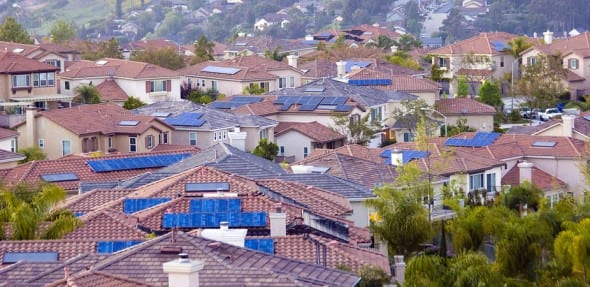The Australian Energy Market Operator predicts that NSW and Victoria will lead the country in the adoption of battery storage by households over the next two decades.
In its first ever analysis of the potential impacts of new technologies – specifically battery storage, but also electric vehicles and “fuel switching” from gas to electricity – AEMO predicts the adoption of battery storage will be rapid, but slow for EVs.
The analysis is driven by the publicity surrounding the release of the Tesla Powerwall, the anticipated cost cuts of battery storage, and the move by major retailers to offer battery storage to consumers.

Broadly, it concludes that while initial pay-back times are high, the take-up rate will still be rapid, with nearly half the forecast capacity by 2034 taken up in the next 10 years.
It notes that this will have a significant benefit for the grid, because it will reduce maximum demand. The vast amounts of rooftop solar in Australia are credited with mostly shifting and narrowing the peaks, but not reducing them.
But it is just the first piece of the puzzle. As AEMO notes, payback and uptake of battery storage can vary immensely, depending on the size and cost of the system (of which little is yet known), assumed cost falls, the size of a solar PV array, and the structure of tariffs. And, for states like Tasmania, the amount of sunshine.
For battery storage, AEMO says three-quarters of households adding solar in NSW will include battery storage, but Victoria will have the most capacity installed by 2034.
The AEMO study, however, does not include battery storage retrofit installations in the 1.4 million households that already have solar. It says this is too difficult to model just now, but it will be its next undertaking.
That explains why NSW and Victoria may lead the market in its estimates. Both have tariff structures and demand profiles (such as time of use metering in Victoria) that would encourage battery storage, and relatively low penetration of rooftop solar to date.
Queensland currently has the most rooftop solar, and South Australia the highest penetration of rooftop solar, reducing the scope of the market within the AEMO parameters.
To put the AEMO forecasts in some context, analysts such as Bloomberg New Energy Finance predict that Australia could have 37,000MW of battery storage by 2040, outstripping the amount of rooftop solar, which it puts at 33,000MW (that includes commercial installations).
AEMO, on the other hand, thinks that rooftop solar installations will outstrip battery storage. It has previously predicted a five-fold increase in solar PV systems to 21,000MW by 2034, although its high scenario could add another 20 per cent, outstripping the capacity of coal fired generation.
It notes that battery storage will have an impact on grid demand. Just the battery storage associated with newly installed solar (and not including retrofits to existing solar arrays ) – could reduce maximum demand in Victoria by 720MW, or 6.2 per cent.
In Queensland and South Australia, the reduction is smaller, but remember this calculation does not include the retrofit market. If that was incorporated – Morgan Stanley has predicted half of the battery storage market could be retrofits – the reduction in peak demand in Victoria would be even higher. This could be critically important to the sizing of the grid, because so much money is spent on bulking up the grid to meet those maximum demand levels.
 As for paybacks, AEMO has taken a more conservative view than most other analysts. That’s because it has been relatively cautious with the costs of battery storage, and it forecasts a flatter cost reduction in coming years. It estimates that an initial decline in costs of 8 per cent in the first year, and an annual decline of 12 per cent thereafter.
As for paybacks, AEMO has taken a more conservative view than most other analysts. That’s because it has been relatively cautious with the costs of battery storage, and it forecasts a flatter cost reduction in coming years. It estimates that an initial decline in costs of 8 per cent in the first year, and an annual decline of 12 per cent thereafter.
Also, it is not including the retrofit market, which could be a big driver for some households, particularly in NSW, where premium feed in tariffs for more than 160,000 homes are due to expire in December, 2016. This has been a big driver of low payback forecasts for Morgan Stanley and UBS, which focused on areas of high time of use tariffs. Queensland solar feed in tariffs, on the other hand, will last another decade, and will not provide a big incentive for battery storage in that time.
AEMO suggests that the payback for battery storage added to new systems in most states is very high. But the interesting graph is the following, which shows how those payback estimates will fall, even with its conservative estimates of cost reductions. (We go into more detail about these paybacks here).
AEMO has adopted a conservative view, expecting the cost curve to decline at a much slower rate than initially predicted by BNEF. AEMO’s projected cost curve was based upon the component costs illustrated above, with manufacturing and technology costs continuing to decrease over time, but at this slower rate.
On the other technologies, AEMO predicts a slow take up of electric vehicles. It notes that only 1,909 electric vehicles were sold to 30 April 2015, and just 0.1% of new vehicle sales in 2014.
“Based on this current level of uptake and the absence of any policy incentives, AEMO assumes the uptake of electric vehicles to continue to be small, with a projected 165,734 electric vehicles across the NEM in 2024–25, increasing to 524,775 in 2034–35.
It also believes that “fuel switching amongst Australian households – from dual gas and electricity systems to electricity only – will stay low and contribute an additional 2,552 GWh (1.2%) to consumption from the grid.
Here are AEMO’s overall thoughts on battery storage installations by state (WA and NOT not included because not part of the National Electricity Market and managed by separate organisations). More can be found here.
Queensland
There is already a relatively high installed capacity of residential rooftop PV in Queensland. Despite 2,046 MWh of battery storage capacity being installed with new rooftop PV over the forecast period, this represents a relatively small percentage of total installed rooftop PV capacity.
New South Wales
The combination of the tariff structure and average household daily demand profile gives consumers in New South Wales economic incentive to install rooftop PV and battery storage. By the end of the forecast period, New South Wales has the largest percentage of installed rooftop PV (72%) that is integrated with battery storage. This will have an impact on grid demand forecasts.
South Australia
South Australia currently has the highest penetration of rooftop PV of all the NEM regions. As in this paper AEMO has only considered uptake of battery storage with new installations of rooftop PV, this reduces the size of the market being modelled in South Australia. In addition, the installation of rooftop PV in South Australia already has a short payback period. The forecasts show that the benefits of installing battery storage compared with rooftop PV alone were limited in South Australia, compared to other NEM regions.
Victoria
Victoria currently has a time-of-use tariff structure that incentivises the uptake of battery storage, as households are able to use electricity from the battery during peak times. Victoria has the highest installed battery capacity (2,774 MWh) by the end of the forecast period, and this results in a sizeable reduction in the summer and winter maximum demand forecasts,
Tasmania
As Tasmania historically has the least amount of solar resource, the payback period is the longest of all NEM regions. However, the percentage of total installed rooftop PV that is integrated with a battery storage system is the third highest of the NEM regions across the forecast period. Despite this uptake, given Tasmania’s maximum demand peak occurs in winter, there is only a small reduction in the 10% POE maximum demand forecasts.













